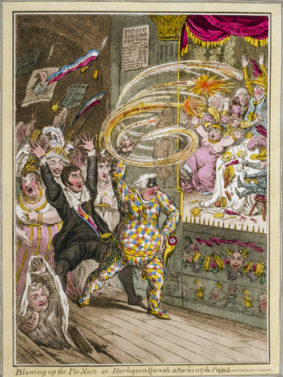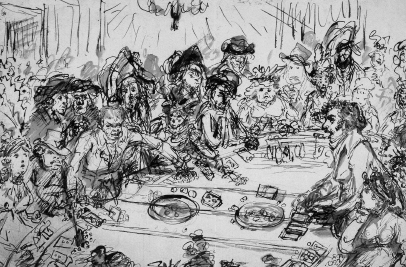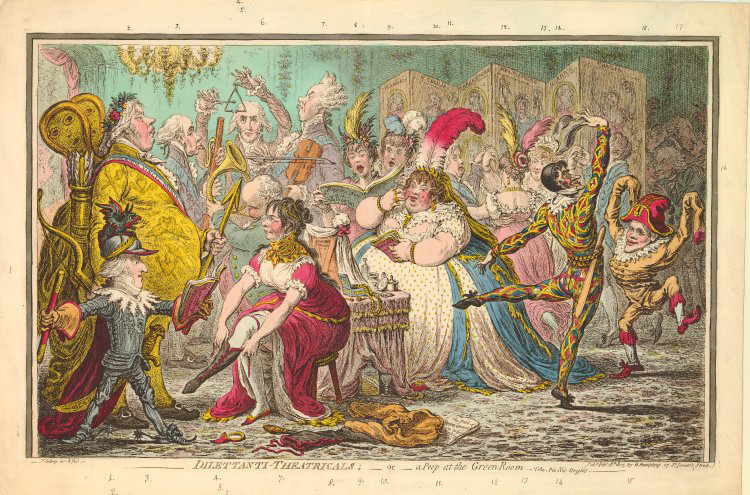The Pic Nic Society attracted obsessive gamblers, eager amateur actors called Dilettanti, and gourmand diners.
Taking advantage of a truce in a decade-long war with France (lead by Napoleon, then First Consul), the Pic Nics wagered (and lost) that London might have a very French subscription society without political scandal. They took their name from the Parisians’ manner of dining en pique-nique, the custom of contributing food or drink to an at-home dinner or splitting the bill in a restaurant. Posh Londoners knew the practice of “clubbing,” sharing expenses or cost of a bill. Still, the Pic Nics took this to a higher level by combining dining, amateur theatrical performances, and gambling. As far as I know, there is no earlier public usage of picnic in English. Philip Stanhope, Lord Chesterfield, used picnic in a personal letter to his son in 1748, but the word picnic passed unnoticed. When the letters were p published in 1774, picnic was noticed, again.

William Sheridan, aka Harlequin Quixote, in motley, leads an attack on the Pic Nics. Lady Buckinghamshire on the stage is bare-breasted. The Pic Nic dinner is overturned. James Gillray. Blowing up the Pic Nic’s; – or – Harlequin Quixote attacking the Puppets. Vide Tottenham Street Pantomime (April 2, 1802). Alludes to Don Quixote, II, Chapters 25-28, when Don Quixote demolishes Don Pedro’s puppet show.
Pic Nics advertised themselves as “fashionables.” Participation was expensive; their motto was “Excess.” The ante for a meeting was £6 (now about $750), six bottles of wine, and an edible contribution to the meal. Still, underwriters needed to cover expenses. Food was prepared or purchased elsewhere and assembled at a trendy catering hall. What each brought to the table was decided by lot, drawn from a hat. According to Henry Angelo, an original Pic Nic, the process was dicey. Lucky Pic Nics might get off cheaply with China oranges [really from Portugal] or a pound cake. Others might need to arrange for pâté de foie gras or very expensive Perigord Pie (made with truffles and game). Besides the wine, diners were provided with champagne, liqueurs, and other beverages.
Euphemistically called “entertainment,” gambling was the deep reason for society. Faro was the card game of choice, and tables were set-up after dinner at which players remained until the early morning hours. The gambling was illegal but not problematic, especially because the Prince of Wales was a constant player.

An evening’s gathering at the table might include dukes, duchesses, and earls; the Prince of Wales (center left), Lady Albania Hobart, Countess of Buckinghamshire (at the head of the table), and the Duchess of Devonshire (obsessive gambler). The managing director was Lt. Col. Henry Francis Greville (the banker, standing right)
Unexpectedly, the amateur theatricals caused a scandal. Fearing the loss of income, William Brinsley Sheridan worried these would affect patronage at the Drury Lane theater, of which he was principal. After some inconclusive discussion with them, Sheridan launched a public relations scheme to derail or even close Pic Nics down. Adding infamy, caricaturist James Gillray attacked the Pic Nics and Sheridan. He did not, however, lampoon the dinners.
Dear Pic,
Am off.—I cannot stand your cloudy atmosphere or the abominable life you all lead. I am hurrying away to Bologna Sausages, Macaroni Sardinia [in the Sardinian style], Garlic, and Oil, with a cloudless sun, and the liberty of doing what I like, without being quizzed by the wits, or lampooned by the newspapers.”
The collateral damage of the Pic Nic demise was a linguistic bonanza for the word picnic. Pic Nic dinners caught on and resurfaced as negative allusions in two children’s stories. In the first, The Courtship, Marriage, and Pic Nic Dinner of Cock Robin and Jenny Wren. To Which Is Added, Alas! The Doleful Death of the Bridegroom (1806), the “pic nic dinner,” ends badly because a jealous and drunken Sparrow shoots and kills the bridegroom Cock Robin. In the second, The Mice, and Their Pic Nic. A Good Moral Tale (1809) Country Mice and City Mice attending an “epicure pic nic dinner” are eaten by a tabby in a London townhouse. [Both stories are discussed elsewhere in Picnic.Wit.com.]
From these adverse beginnings, picnic (variously spelled pic nic, pic-nic, picknick) regularly appears in literature and art, sometimes negative but more often in a positive light. Setting shifted, too, from indoor to outdoor dining. After centuries of not having a proper name, the alfresco meal became a picnic. Only the French continued to use pique-nique to connote a dining room meal until long after.
Featured Image: Sheridan, aka Harlequin Quixote, in motley leads an attack on the Pic Nics. Lady Buckinghamshire on the stage is bare-breasted. The Pic Nic dinner is overturned. James Gillray. Blowing up the Pic Nic’s; – or – Harlequin Quixote attacking the Puppets. Vide Tottenham Street Pantomime (April 2, 1802). See Don Quixote, II, chapter 25-28, in which Don Quixote demolishes Don Pedro’s puppet show.
Dilettanti Theatrical;-or-a Peep at the Green Room. Vide Pic-Nic Orgies preparing for an evening’s performance. Lord Cholmondeley dressed as Cupid is in yellow; Lady Buckinghamshire is the obese woman in white; the Earl of Mount-Edgecombe is the small man in the dragon hat; Col. Greville is in the rear holding a triangle, and Lady Salisbury adjusting her boot alludes to Hogarth’s Rake’s Progress. The Prince of Wales, under Buckinghamshire’s red and white feather, stands with his two mistresses.
See William Combe, editor. The Pic Nic. London: 1803; Thomas Wright and R.H. Evans. Historical and Descriptive Account of the Caricatures of James Gillray: Comprising a Political and Humorous History of the Latter Part of the Reign of George the Third London: Henry G. Bohn, 1851; James Gillray, James. The Works of James Gillray, the Caricaturist. Edited by Joseph Grego. London: Chatto & Windus, 1873; Henry Angelo. Reminiscences of Henry Angelo. London: H. Colburn and R. Bentley, 1830; Sybil Rosenfeld. Temples of Thespis. London: Society for Theatre Research, 1978.

